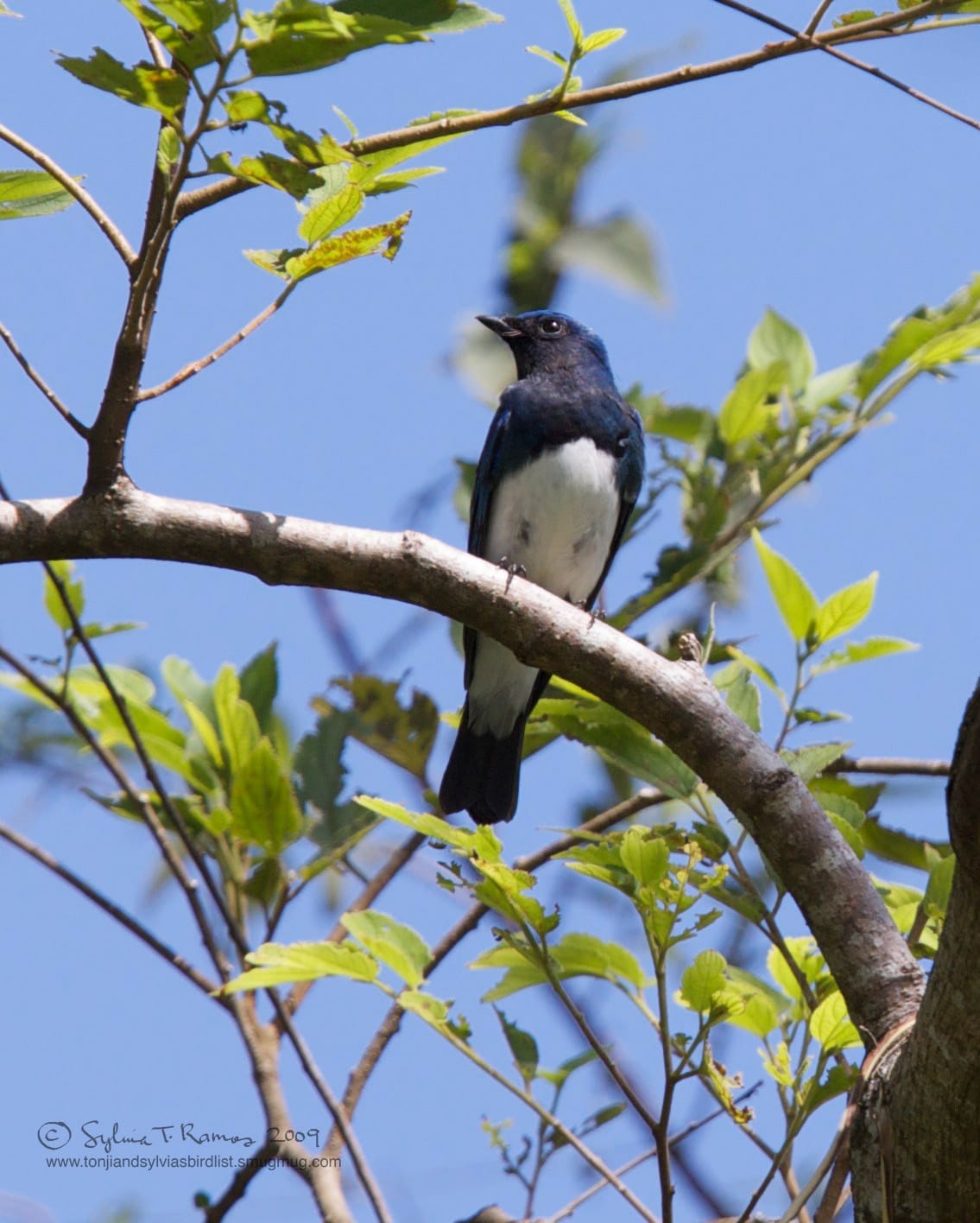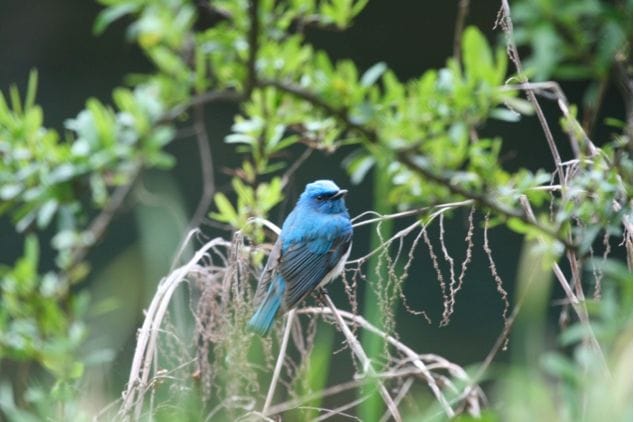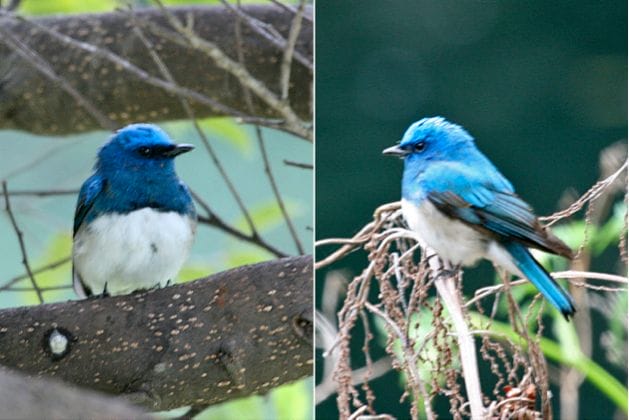Christian Perez discusses three species that were split in the WBCP Checklist of Birds of the Philippines 2013: Oriental Cuckoo, Oriental Bush-Warbler, and Blue-and-White Flycatcher. He has gathered expert information from different sources and explains how to tell the species apart and how the splits affect personal Philippine lists.
—
The Oriental Cuckoo and Other Splits
by Christian Perez
In previous EBON articles I covered two migratory species splits: the Black-winged/White-headed Stilt, and the Arctic/Kamchatka/Japanese Leaf Warbler. Three more species of migratory birds listed in Kennedy were split in the WBCP Checklist of Birds of the Philippines 2013: the Oriental Cuckoo, the Oriental Bush-Warbler, and the Blue-and-white Flycatcher.
Oriental Cuckoo – always silent!
Kennedy indicates that two races of the Oriental Cuckoo Cuculus saturatus occur in the Philippines (horsfieldi – later renamed optatus, and saturatus), that they differ in size (horsfieldi is larger), and that some authors have split the species based on call during breeding, and size. The Oriental Cuckoo is an uncommon bird. WBCP records show 32 sightings throughout the country from 2003 to 2012.
In a 2005 paper (http://www.scricciolo.com/BOC/KING_Vol125.pdf), Ben King proposed that the Oriental Cuckoo be split into Oriental Cuckoo, Himalayan Cuckoo, and Sunda Cuckoo (the last one not reported in the Philippines). The IOC (International Ornithological Committee) later accepted the split, which was therefore reflected in the WBCP Checklist 2013. The Oriental Cuckoo was split into Himalayan Cuckoo Cuculus saturatus and Oriental Cuckoo C. optatus in the WBCP list.
According to IOC, the Himalayan Cuckoo breeds from the Himalayas to Taiwan while the Oriental Cuckoo breeds in northeast Asia. Both species winter south including in the Philippines, can occur on every island, and therefore cannot be separated based on location. The two species vary slightly in size and wing length, but to separate them based on size in the field would require the two species to be seen side by side. They are so uncommon in the Philippines that this is a most unlikely situation.
As discussed in a paper published in Forktail in 2007 (http://birdingasia.org/wp-content/uploads/2012/09/Lindholm-Cuckoo.pdf), the two species have distinct calls. The problem is that they only call during breeding and are normally silent while wintering in the Philippines. I know this is frustrating, but the conclusion is that the two species cannot normally be separated in the field in the Philippines. In this case it should be reported as Oriental/Himalayan Cuckoo sp. in WBCP trip reports.
According to Kennedy they are recorded from 12 September to 7 June. You might be extremely lucky to observe one that would call in the Philippines at the end of the season. In that unlikely event it would be important to record the call for comparison with pre-recorded calls, and for review by experts. Rob Hutchinson reported that on 3 occasions (twice Himalayan, once Oriental) the bird responded to one call but not the other by flying silently overhead. This seems to happen mostly in April, as the birds head to their breeding grounds with presumably higher hormone levels. It is certainly worth a try! Kennedy provides a list of islands where each of the two races has been recorded. They were probably identified by measuring caught specimens.



Impact on personal Philippine lists
When the new WBCP checklist 2014 was announced in January 2014, many Philippine birders reviewed the splits and if they had seen some of the subspecies that had been elevated to species, they quickly added the new species in their Philippine lists as “armchair lifers”. By the same logic, Philippine birders should have removed from their lists the Black-winged Stilt, the Arctic Warbler and the Oriental Cuckoo as they could not be sure of which ones of the new species they had seen. However, I don’t know of any birder who did that. They just kept the Black-winged Stilt and the Artic Warbler in their lists, waiting for future sightings to confirm them and to add the new species resulting from the splits.
This is a bit more frustrating with the Oriental Cuckoo. I have to admit that I kept the Oriental Cuckoo on my Philippine list and renamed it Oriental/Himalayan Cuckoo since I don’t know which one I actually saw. In view of the difficulty of separating them in the field in the Philippines, I personally think that this practice should be acceptable for personal Philippine lists, or for example for future big year lists.
Oriental Bush-Warbler – a real mess!
The Oriental Bush-Warbler Cettia diphone listed in Kennedy has been split into Japanese Bush Warbler Horomis diphone and Manchurian Bush Warbler H. borealis in the WBCP Checklist 2013.
Although Kennedy says that races “vary mainly by colour of upperparts”, the arrangement described in Kennedy does not correspond to the new IOC species. Kennedy adds that “some authors separate this species into 2 species, Japanese Bush-Warbler Cettia diphone including the race borealis, and Manchurian Bush-Warbler Cettia canturians.” On the other hand, IOC states that “Manchurian Bush Warbler is restricted to borealis; Ssp canturians is treated here as a subspecies of H. diphone.” A check of other sources shows that there is no consensus on this, and that there is much confusion about these two species. Birds of East Asia (Brazil 2009), the most up-to-date guide to the region, has yet another arrangement with Japanese Bush Warbler Cettia diphone separated from ‘Korean’ Bush Warbler Cettia canturians which includes borealis! The following might make it clearer:
———————- Japanese Manchurian/Korean
IOC diphone + canturians borealis
KENNEDY diphone + borealis canturians
BRAZIL diphone canturians + borealis
The birds are extremely difficult to separate in the field but if you’re lucky enough to find one then concentrating on the amount of chestnut in the plumage, the strength of the supercilium (pale stripe above the eye), amount of wash on the underparts and presence or absence of chestnut tones on the forehead, might allow an identification. Even better, if you think you’re seeing a Japanese or Manchurian Bush Warbler, try to obtain high quality pictures and sound recordings, to allow study by experts for confirmation and identification.
The Oriental Bush-Warbler is described as uncommon by Kennedy, but is actually either rare or underreported as the WBCP records do not show a single sighting from 2003 to 2012. One Oriental Bush-Warbler was reported by Trinket Constantino in May 2013 in Sagada (note that the 2013 trip reports have not yet been encoded into the official WBCP database). Des Allen posted on the Internet Bird Collection (IBC) website this video of a bush warbler taken in 2009 in Tadao, Ilocos Norte. Although IBC lumps it under Japanese Bush Warbler, the exact identification (Japanese or Manchurian) is uncertain.
Blue-and-white Flycatcher – a Zappey split!
The Blue-and-white Flycatcher Cyanoptila cyanomelana listed in Kennedy was split into Blue-and-white Flycatcher C. cyanomelana and Zappey’s Flycatcher C. cumatilis in the WBCP Checklist 2013, with a note that Zappey’s Flycatcher is “known only from one specimen collected on Luzon and one collected on Palawan”. The split was proposed in a paper published in Forktail no. 28 dated August 2012: “Leader, P. J. and Carey, G. J. 2012. Zappey’s Flycatcher Cyanoptila cumatilis, a forgotten Chinese breeding endemic”. The paper can be downloaded here: https://groups.yahoo.com/neo/groups/BirdwatchPhilippines/files/EBON/
The post-split Blue-and-white Flycatcher breeds in northeast China, southeast Russia, Korea and Japan, while the Zappey’s Flycatcher breeds in central China. The Zappey’s Flycatcher was named after Dutch ornithologist Walter R. Zappey who caught the type specimen in 1907 in Hubei Province, China.
The two races that resulted in the split are described by Kennedy but the descriptions are not considered reliable in all cases. The paper that proposed the split contains much more detailed descriptions of the differences (including differences between two races of the Blue-and-white). If you think you saw a Blue-and-white or a Zappey’s Flycatcher, it would be a good idea to refer to the paper. Better still, field notes and pictures should be sent to experts for confirmation.
The species is classified as rare by Kennedy. WBCP records show 30 sightings from 2003 to 2012, including 21 sightings in 2009 alone (there may be multiple sightings of the same individuals on different days). The specific identification of many of these might be unknown but a pair observed and photographed by several WBCP members in Mount Palay Palay in November 2009 can be identified as a post-split Blue-and-white Flycatcher based on Kennedy’s description.



http://snowyowllost.blogspot.com/2013/04/zappeys-flycatcher-cyanoptila-cumatilis.html

UPDATE IN FEBRUARY 2020: The Rarities Committee examined the two specimen of Zappey’s Flycatcher stored at American Museum of Natural History and concluded that they can not be identified at species level because one is a female and the other a juvenile. The two records were therefore invalidated by the Committee and the Zappey’s Flycatcher removed from the 2020 Checklist of the Birds of the Philippines.

Pingback:June 2014 | e-BON
Hi Christian, in your paper about the Oriental and the Himalayan Cuckoo you state as follows: “According to IOC, … Both species winter south including in the Philippines, …”
That gave me the impression that the IOC World Birdlist lists both species for Philippines during the northern winter.
When checking IOC list 4.2 I found that both species are not listed for the Philippines.
Maybe I misinterpreted your writing – please, let me have your explanation.
With many thanks and my very best wished, Thomas
Hi Thomas,
Thanks for your comment. IOC only describes the breeding range and my IOC reference was only for that first sentence. The wintering range for the two subspecies (now species) is described in Kennedy. I agree that my wording was confusing and that I should have started the second sentence with the words “According to Kennedy, both species winter …”
Christian
Pingback:Gino and the Cuckoo | e-BON
Hi, I was trying to find tips on how to decipher between oriental and himalayan cuckoos. The paper cited at the beginning says their songs are distinct, but I cannot find any source (on Youtube, Wikipedia, etc.) that provides side-by-side comparisons of their songs. Could you help me, please?
The difference in songs is discussed in the referenced Forktail article (http://birdingasia.org/wp-content/uploads/2012/09/Lindholm-Cuckoo.pdf). Example of calls and songs can be heard on xeno-canto (https://www.xeno-canto.org/explore?query=himalayan+cuckoo).